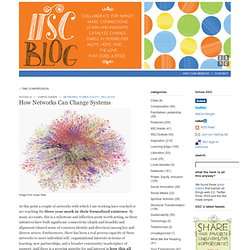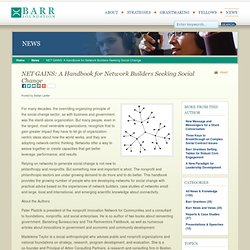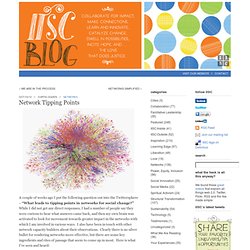

How Networks Can Change Systems. Oct/02/14//Curtis Ogden//Networks, Power, Equity, Inclusion Image from Isaac Mao At this point a couple of networks with which I am working have reached or are reaching the three year mark in their formalized existence.

By many accounts, this is a milestone and inflection point worth noting, as these initiatives have built significant connectivity (depth and breadth) and alignment (shared sense of common identity and direction) among key and diverse actors. Furthermore, there has been a real proven capacity of these networks to meet individual self/ organizational interests in terms of learning, new partnerships, and a broader community/marketplace of support. And there is a growing appetite for and interest in how this all adds up to significant system change. Three related thoughts about how these networks might achieve systemic change: Change who and what matters.
Comment//Share This//Permalink// Like [1] NET GAINS: A Handbook for Network Builders Seeking Social Change. For many decades, the overriding organizing principle of the social-change sector, as with business and government, was the stand-alone organization.

But many people, even in the largest, most venerable organizations, recognize that to gain greater impact they have to let go of organization-centric ideas about how the world works, and they are adopting network-centric thinking. Networks offer a way to weave together or create capacities that get better leverage, performance, and results. Relying on networks to generate social change is not new to philanthropy and nonprofits. But something new and important is afoot. The nonprofit and philanthropic sectors are under growing demand to do more and to do better. About the Authors Peter Plastrik is president of the nonprofit Innovation Network for Communities and a consultant to foundations, nonprofits, and social enterprises.
The report can be downloaded below. Network Tipping Points. Oct/10/12//Curtis Ogden//Networks A couple of weeks ago I put the following question out into the Twittersphere – “What leads to tipping points in networks for social change?”

While I did not get any direct responses, I had a number of people say they were curious to hear what answers came back, and then my own brain was activated to look for movement towards greater impact in the networks with which I am involved in various ways. I also have been in touch with other network capacity builders about their observations. Clearly there is no silver bullet for rendering networks more effective, but there are some key ingredients and rites of passage that seem to come up in most. Here is what I’ve seen and heard: Different parts of the network start at different starting points, and therefore will have different progressions.
What else? Comments [9]//Share This//Permalink// Google Image Result for. 6 feet of junk mail or a 29% response rate? Blyk shows the way. Its a bit of a no brainer really.

There are a few themes here that I want to touch on. But this post relates to Blyk and where its recent results suggest where and how advertising money is going to be spent in the very near future. And the reason is this. Blyk announces that there is a clear trend emerging from the 498 campaigns delivered on the blyk service during Sep 24, 2007 – Jan 24, 2008. These are: Average response rate 29% Average SMS response rate 41% Average MMS response rate 22% Really engaging communications consistently receive responses over 50% So - firstly we see a disproportionate success rate when campaigns are Engaging but also an incredible mean average of 29%.
Wireless Sensor Network. Radio Frequency Identification RFID is a generic technology concept that refers to the use of radio waves to identify objects (Auto-ID Center, 2002).

All labels or RFID tags have a chip and an antenna. Hierarchy and Network: Two Structures, One Organization. Top 10 Reasons to Join a Social Network. Why do you have a network? Every now and then “network” seems like a dirty word. Have you ever asked someone about going to a networking event and see them wince? Networking was never that big of a deal for me because I generally like meeting new people.
Without reaching out to my friend M-W, I’ll simply say that networks are groups of people with whom we have connections. Your friends are a part of your network. Alumni groups, co-workers, volunteer partners…all of these people are a part of your network. And for the record, I don’t view a network as some object that we build and put on a shelf somewhere for safe keeping. You need to actively focus on your network, adding value when you can and extracting value when you need to.
I’m entering a phase where a lot of my networking efforts will involve alumni groups and volunteer efforts. This week, I will enter hyperdrive mode when I become the Chair of the GW Black Alumni Association. Google Image Result for. Google Image Result for. Google Image Result for. Google Image Result for. Google Image Result for. Google Image Result for. Google Image Result for. Google Image Result for.
Google Image Result for. Google Image Result for.
Google Image Result for.